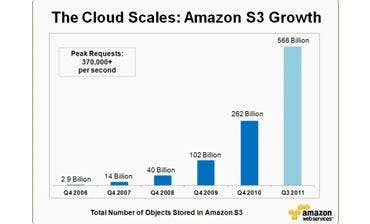Amazon S3 Cloud Storage Objects Have Doubled In 2011
Amazon Web Services cloud storage
According to Amazon, the company's S3 cloud storage had 566 billion objects in S3 at the close of the third quarter of 2011. And Amazon Evangelist Jeff Barr was quick to point out that many of the 566 billion objects are PUT requests, which represent new data flowing into Amazon S3.

At the same time, Barr wrote in a blog post that Amazon S3 now processes up to 370,000 S3 requests per second.
The leap to 566 billion objects in Amazon S3 cloud storage is a major increase on Amazon S3's 449 billion stored objects at the end of 2011's second quarter, which also saw Amazon S3 processing up to 290,000 requests per second at peak times. Meanwhile, 566 billion is an even bigger bump compared to the 262 billion objects stored in the fourth quarter of 2010.
Amazon S3 cloud storage has been on a steady upward climb. From the fourth quarter of 2006 to the fourth quarter of 2009, the amount of stored objects on Amazon's cloud increased by more than 100 percent each year, from 2.9 billion in 2006, to 14 billion in 2007, to 40 billion in 2008 and to 102 billion in 2009.
"We've doubled the object count in just nine months [the other data points are from Q4]," Barr wrote. "My math skills are a bit rusty but I definitely know exponential growth when I see it!"
Amazon's S3 success is just one component of Amazon Web Services' cloud domination. While the Seattle-based company keeps its cloud numbers close to the vest, the number of objects in Amazon S3 cloud storage gives a small glimpse into Amazon's cloud dominance.
Amazon doesn't share the revenue generated by its Amazon Web Services cloud offerings. Instead, Amazon's cloud plays are lumped in a category called "other" in Amazon's quarterly earnings reports. The "other" category contains revenues not generated by media or electronics or other general merchandise. In Amazon's second-quarter financial results from 2011, the company reported revenue of $9.91 billion. Of that $9.91 billion, $359 million, or just over 3.5 percent of Amazon's overall revenue, was "other" revenue. Amazon's "other" sales, however, grew 77 percent year-over-year from the second quarter of 2010 to second quarter 2011.
Still, Amazon's tremendous cloud growth has some market watchers estimating that Amazon Web Services cloud could be a $1 billion business come 2012.
"While still very small for Amazon [likely about $750 million revenue run- rate], given the size of the market opportunity and Amazon's strong competitive positioning, we believe that this could soon be a $1 billion revenue segment," Citigroup Internet analyst Mark Mahaney said in a note to investors in July, just before Amazon reported its second- quarter earnings.
Meanwhile, other analysts expected AWS to generate even higher revenues, with one JPMorgan Chase analyst estimating that AWS could drive a whopping $2.6 billion come 2015.
Those lofty projections come on the heels of earlier estimations from UBS that Amazon's cloud revenue reached $500 million in 2010, would hit $750 million in 2011 and could top $2.5 billion in 2014.
And Amazon continues to bang the cloud computing drum, with the recent launches of its Amazon Cloud Drive and Amazon Cloud Player offerings and the upcoming Amazon Kindle Fire, Amazon's touch-screen tablet that leverages its cloud computing environment.
Amazon Web Services also recently earned Federal Information Security Management Act (FISMA) Moderate Authorization and Accreditation, which illustrates that AWS and its cloud plays are suitable for federal, state and local governments. The FISMA accreditation came on the heels of Amazon launching AWS GovCloud, a government-focused cloud service that offers federal agencies a more secure cloud computing environment.